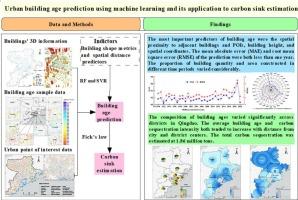Urban building age prediction using machine learning and its application to carbon sink estimation
IF 7.1
2区 工程技术
Q1 CONSTRUCTION & BUILDING TECHNOLOGY
引用次数: 0
Abstract
Building age is significant for urban planning, energy demand estimation and climate change mitigation. This paper utilized building shape metrics, spatial indicators, and explanatory distance predictors of point of interest (POI) data to predict building age, based on 32,826 sample buildings in Qingdao City. The spatial cross-validation (SP-CV) method was used for the evaluation of predictors’ contribution to building age in Random Forest model and the prediction of building age in Support Vector Regression model. The study analyzed the building age characteristics and estimated the carbon sequestration of concrete buildings. The results showed that the distance to 8 adjacent buildings and the POIs, building height and coordinates were significant predictors of building age. The coefficient of determination (R2) exceeded 0.8, and both the mean absolute error (MAE) and root mean square error (RMSE) were less than one year. More than 57 % of the buildings in Qingdao City were over 30 years old. Low-rise buildings and residential buildings have the highest average ages, at 25.7 and 24.7 years, respectively. The average building age increased with distance from the city and district centers. The total carbon sequestration of concrete buildings was estimated at 1.86 million tons in Qingdao City. These findings are critical for urban-scale building energy estimation, urban risk assessment, and climate change mitigation, and they provide valuable insights for urban planning and low-carbon urban renewal.

基于机器学习的城市建筑年龄预测及其在碳汇估算中的应用
建筑年龄对于城市规划、能源需求估算和减缓气候变化具有重要意义。本文基于青岛市32,826栋样本建筑,利用建筑形状指标、空间指标和兴趣点(POI)数据的解释距离预测因子对建筑年龄进行了预测。采用空间交叉验证(SP-CV)方法评价随机森林模型中预测因子对建筑楼龄的贡献,并采用支持向量回归模型对建筑楼龄进行预测。研究分析了混凝土建筑的年龄特征,估算了混凝土建筑的固碳量。结果表明,与相邻8栋建筑的距离、建筑高度和坐标是建筑年龄的显著预测因子。决定系数(R2)均大于0.8,平均绝对误差(MAE)和均方根误差(RMSE)均小于1年。青岛市57%以上的建筑楼龄超过30年。低层建筑和住宅的平均楼龄最高,分别为25.7年和24.7年。随着距离城市和地区中心的距离增加,平均建筑年龄也在增加。青岛市混凝土建筑固碳总量估计为186万吨。这些发现对于城市尺度的建筑能源估算、城市风险评估和气候变化减缓至关重要,并为城市规划和低碳城市更新提供了宝贵的见解。
本文章由计算机程序翻译,如有差异,请以英文原文为准。
求助全文
约1分钟内获得全文
求助全文
来源期刊

Energy and Buildings
工程技术-工程:土木
CiteScore
12.70
自引率
11.90%
发文量
863
审稿时长
38 days
期刊介绍:
An international journal devoted to investigations of energy use and efficiency in buildings
Energy and Buildings is an international journal publishing articles with explicit links to energy use in buildings. The aim is to present new research results, and new proven practice aimed at reducing the energy needs of a building and improving indoor environment quality.
 求助内容:
求助内容: 应助结果提醒方式:
应助结果提醒方式:


